Analysis of UPS: Recruitment, Leadership, Teamwork and Motivation
VerifiedAdded on 2020/07/23
|10
|4069
|64
Report
AI Summary
This report analyzes the recruitment and selection process, leadership styles, and team dynamics within UPS, a major UK parcel company. It covers essential documentation required for recruitment, including job descriptions and specifications, and discusses the impact of legal and ethical considerations, such as equality and race relations acts. The report details the selection process stages, from shortlisting to appointments, highlighting the HR manager's role. It then explores leadership skills, differentiating between leadership and management, and comparing various leadership styles like Laissez-Faire, Participative, and Autocratic, offering insights into their applicability. Furthermore, the report examines strategies for motivating staff, such as communication, empowerment, and fostering an open work environment, while also evaluating team effectiveness and the assessment of individual development needs. The conclusion summarizes the key findings and recommendations for improving these critical areas within UPS.
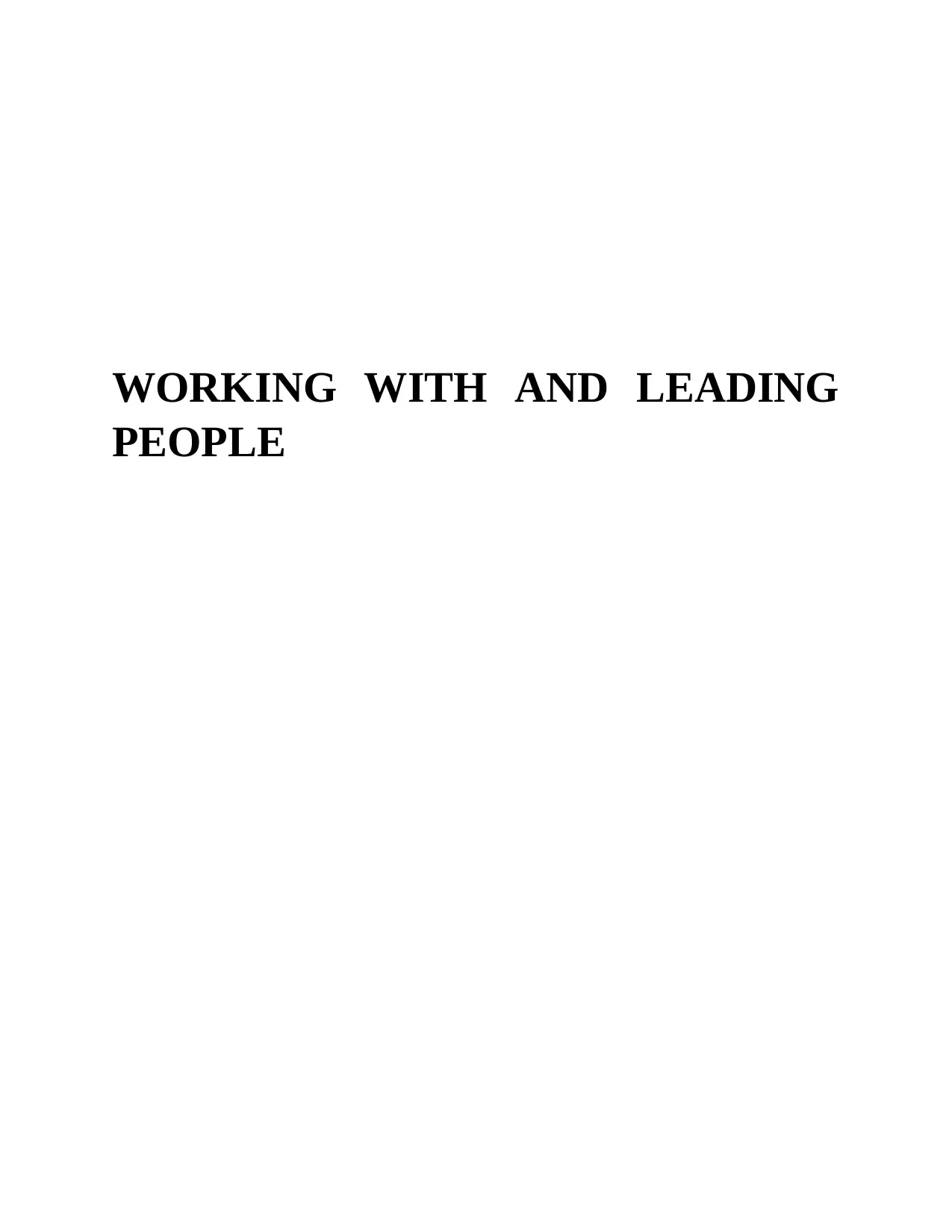
WORKING WITH AND LEADING
PEOPLE
PEOPLE
Paraphrase This Document
Need a fresh take? Get an instant paraphrase of this document with our AI Paraphraser
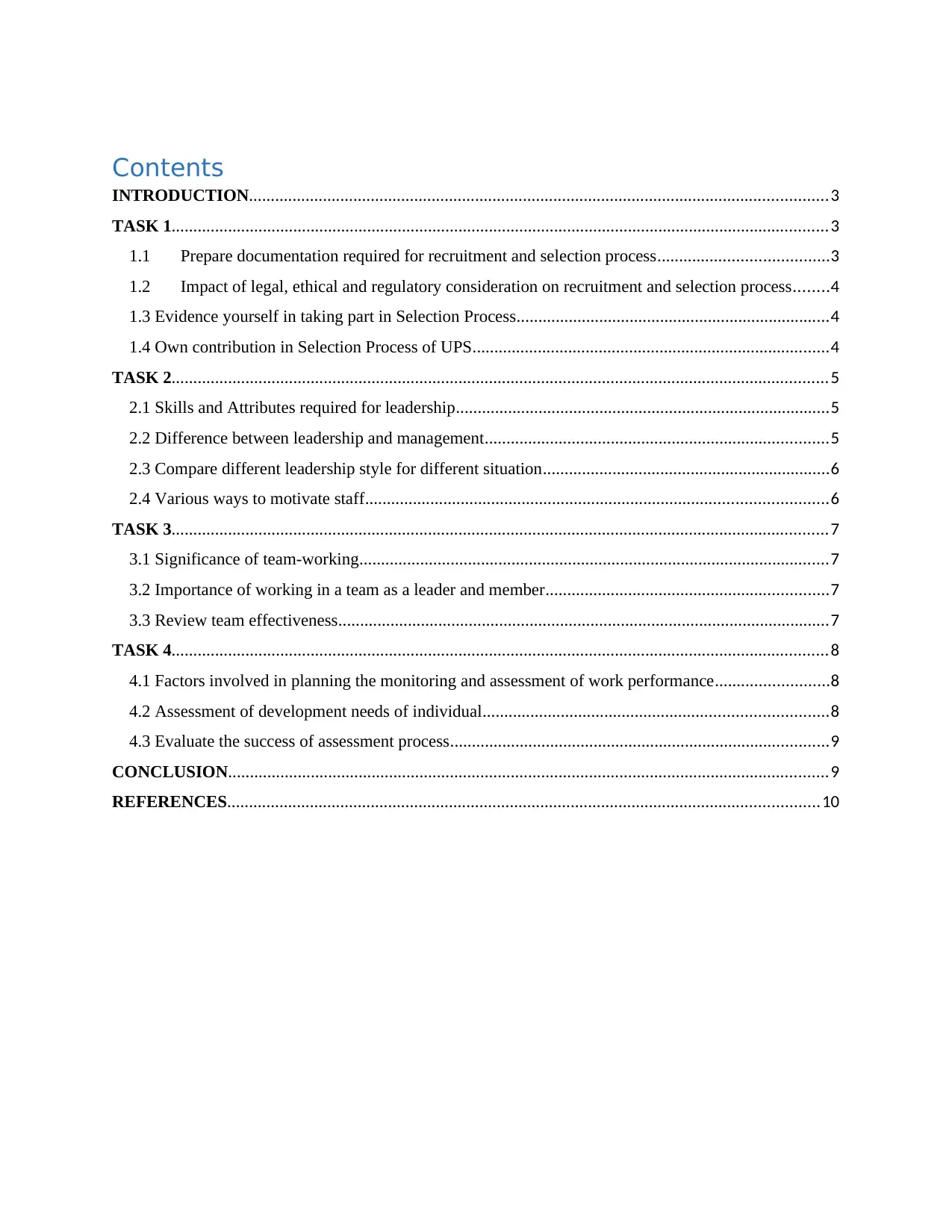
Contents
INTRODUCTION.....................................................................................................................................3
TASK 1.......................................................................................................................................................3
1.1 Prepare documentation required for recruitment and selection process.......................................3
1.2 Impact of legal, ethical and regulatory consideration on recruitment and selection process........4
1.3 Evidence yourself in taking part in Selection Process........................................................................4
1.4 Own contribution in Selection Process of UPS..................................................................................4
TASK 2.......................................................................................................................................................5
2.1 Skills and Attributes required for leadership......................................................................................5
2.2 Difference between leadership and management...............................................................................5
2.3 Compare different leadership style for different situation..................................................................6
2.4 Various ways to motivate staff..........................................................................................................6
TASK 3.......................................................................................................................................................7
3.1 Significance of team-working............................................................................................................7
3.2 Importance of working in a team as a leader and member.................................................................7
3.3 Review team effectiveness.................................................................................................................7
TASK 4.......................................................................................................................................................8
4.1 Factors involved in planning the monitoring and assessment of work performance..........................8
4.2 Assessment of development needs of individual...............................................................................8
4.3 Evaluate the success of assessment process.......................................................................................9
CONCLUSION..........................................................................................................................................9
REFERENCES........................................................................................................................................10
INTRODUCTION.....................................................................................................................................3
TASK 1.......................................................................................................................................................3
1.1 Prepare documentation required for recruitment and selection process.......................................3
1.2 Impact of legal, ethical and regulatory consideration on recruitment and selection process........4
1.3 Evidence yourself in taking part in Selection Process........................................................................4
1.4 Own contribution in Selection Process of UPS..................................................................................4
TASK 2.......................................................................................................................................................5
2.1 Skills and Attributes required for leadership......................................................................................5
2.2 Difference between leadership and management...............................................................................5
2.3 Compare different leadership style for different situation..................................................................6
2.4 Various ways to motivate staff..........................................................................................................6
TASK 3.......................................................................................................................................................7
3.1 Significance of team-working............................................................................................................7
3.2 Importance of working in a team as a leader and member.................................................................7
3.3 Review team effectiveness.................................................................................................................7
TASK 4.......................................................................................................................................................8
4.1 Factors involved in planning the monitoring and assessment of work performance..........................8
4.2 Assessment of development needs of individual...............................................................................8
4.3 Evaluate the success of assessment process.......................................................................................9
CONCLUSION..........................................................................................................................................9
REFERENCES........................................................................................................................................10
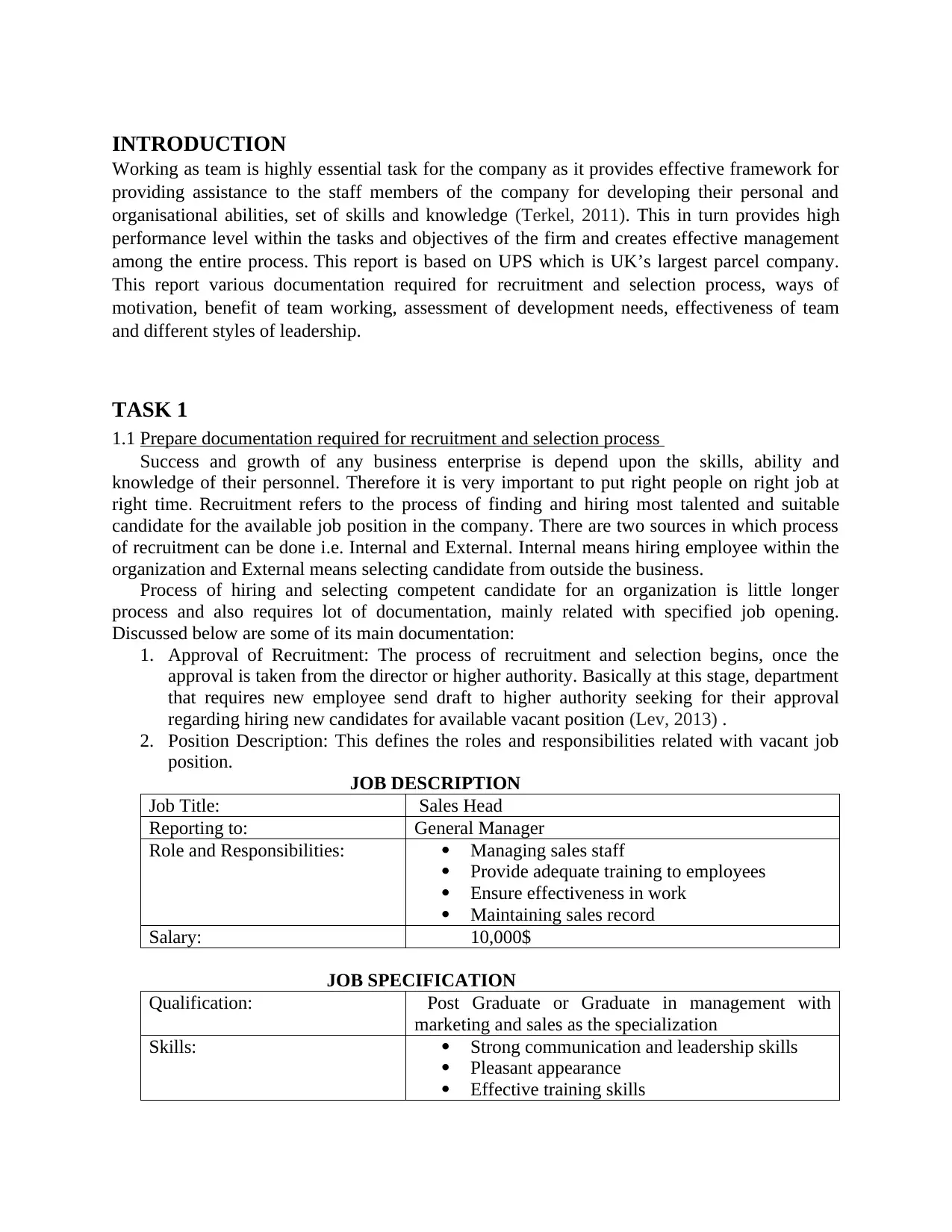
INTRODUCTION
Working as team is highly essential task for the company as it provides effective framework for
providing assistance to the staff members of the company for developing their personal and
organisational abilities, set of skills and knowledge (Terkel, 2011). This in turn provides high
performance level within the tasks and objectives of the firm and creates effective management
among the entire process. This report is based on UPS which is UK’s largest parcel company.
This report various documentation required for recruitment and selection process, ways of
motivation, benefit of team working, assessment of development needs, effectiveness of team
and different styles of leadership.
TASK 1
1.1 Prepare documentation required for recruitment and selection process
Success and growth of any business enterprise is depend upon the skills, ability and
knowledge of their personnel. Therefore it is very important to put right people on right job at
right time. Recruitment refers to the process of finding and hiring most talented and suitable
candidate for the available job position in the company. There are two sources in which process
of recruitment can be done i.e. Internal and External. Internal means hiring employee within the
organization and External means selecting candidate from outside the business.
Process of hiring and selecting competent candidate for an organization is little longer
process and also requires lot of documentation, mainly related with specified job opening.
Discussed below are some of its main documentation:
1. Approval of Recruitment: The process of recruitment and selection begins, once the
approval is taken from the director or higher authority. Basically at this stage, department
that requires new employee send draft to higher authority seeking for their approval
regarding hiring new candidates for available vacant position (Lev, 2013) .
2. Position Description: This defines the roles and responsibilities related with vacant job
position.
JOB DESCRIPTION
Job Title: Sales Head
Reporting to: General Manager
Role and Responsibilities: Managing sales staff
Provide adequate training to employees
Ensure effectiveness in work
Maintaining sales record
Salary: 10,000$
JOB SPECIFICATION
Qualification: Post Graduate or Graduate in management with
marketing and sales as the specialization
Skills: Strong communication and leadership skills
Pleasant appearance
Effective training skills
Working as team is highly essential task for the company as it provides effective framework for
providing assistance to the staff members of the company for developing their personal and
organisational abilities, set of skills and knowledge (Terkel, 2011). This in turn provides high
performance level within the tasks and objectives of the firm and creates effective management
among the entire process. This report is based on UPS which is UK’s largest parcel company.
This report various documentation required for recruitment and selection process, ways of
motivation, benefit of team working, assessment of development needs, effectiveness of team
and different styles of leadership.
TASK 1
1.1 Prepare documentation required for recruitment and selection process
Success and growth of any business enterprise is depend upon the skills, ability and
knowledge of their personnel. Therefore it is very important to put right people on right job at
right time. Recruitment refers to the process of finding and hiring most talented and suitable
candidate for the available job position in the company. There are two sources in which process
of recruitment can be done i.e. Internal and External. Internal means hiring employee within the
organization and External means selecting candidate from outside the business.
Process of hiring and selecting competent candidate for an organization is little longer
process and also requires lot of documentation, mainly related with specified job opening.
Discussed below are some of its main documentation:
1. Approval of Recruitment: The process of recruitment and selection begins, once the
approval is taken from the director or higher authority. Basically at this stage, department
that requires new employee send draft to higher authority seeking for their approval
regarding hiring new candidates for available vacant position (Lev, 2013) .
2. Position Description: This defines the roles and responsibilities related with vacant job
position.
JOB DESCRIPTION
Job Title: Sales Head
Reporting to: General Manager
Role and Responsibilities: Managing sales staff
Provide adequate training to employees
Ensure effectiveness in work
Maintaining sales record
Salary: 10,000$
JOB SPECIFICATION
Qualification: Post Graduate or Graduate in management with
marketing and sales as the specialization
Skills: Strong communication and leadership skills
Pleasant appearance
Effective training skills
⊘ This is a preview!⊘
Do you want full access?
Subscribe today to unlock all pages.

Trusted by 1+ million students worldwide
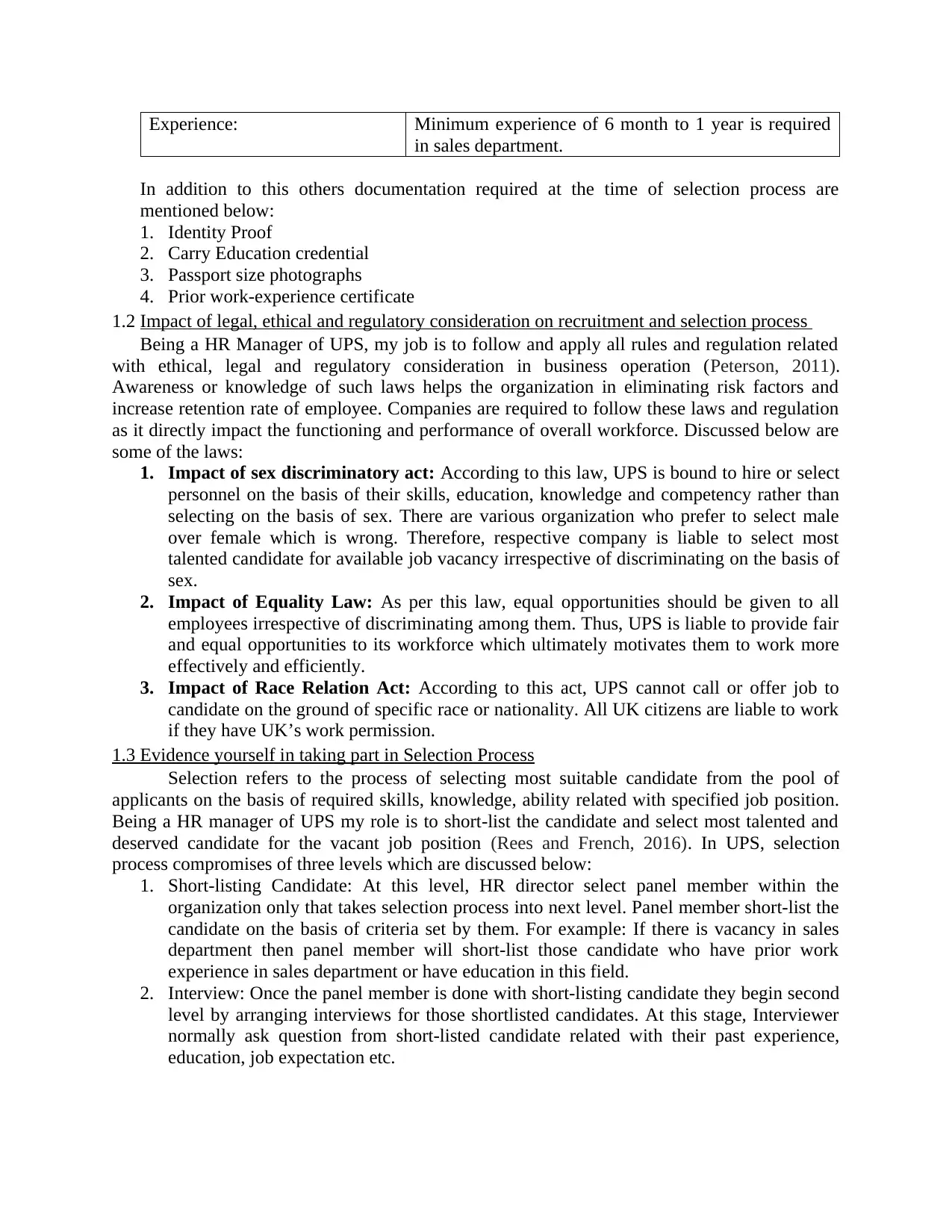
Experience: Minimum experience of 6 month to 1 year is required
in sales department.
In addition to this others documentation required at the time of selection process are
mentioned below:
1. Identity Proof
2. Carry Education credential
3. Passport size photographs
4. Prior work-experience certificate
1.2 Impact of legal, ethical and regulatory consideration on recruitment and selection process
Being a HR Manager of UPS, my job is to follow and apply all rules and regulation related
with ethical, legal and regulatory consideration in business operation (Peterson, 2011).
Awareness or knowledge of such laws helps the organization in eliminating risk factors and
increase retention rate of employee. Companies are required to follow these laws and regulation
as it directly impact the functioning and performance of overall workforce. Discussed below are
some of the laws:
1. Impact of sex discriminatory act: According to this law, UPS is bound to hire or select
personnel on the basis of their skills, education, knowledge and competency rather than
selecting on the basis of sex. There are various organization who prefer to select male
over female which is wrong. Therefore, respective company is liable to select most
talented candidate for available job vacancy irrespective of discriminating on the basis of
sex.
2. Impact of Equality Law: As per this law, equal opportunities should be given to all
employees irrespective of discriminating among them. Thus, UPS is liable to provide fair
and equal opportunities to its workforce which ultimately motivates them to work more
effectively and efficiently.
3. Impact of Race Relation Act: According to this act, UPS cannot call or offer job to
candidate on the ground of specific race or nationality. All UK citizens are liable to work
if they have UK’s work permission.
1.3 Evidence yourself in taking part in Selection Process
Selection refers to the process of selecting most suitable candidate from the pool of
applicants on the basis of required skills, knowledge, ability related with specified job position.
Being a HR manager of UPS my role is to short-list the candidate and select most talented and
deserved candidate for the vacant job position (Rees and French, 2016). In UPS, selection
process compromises of three levels which are discussed below:
1. Short-listing Candidate: At this level, HR director select panel member within the
organization only that takes selection process into next level. Panel member short-list the
candidate on the basis of criteria set by them. For example: If there is vacancy in sales
department then panel member will short-list those candidate who have prior work
experience in sales department or have education in this field.
2. Interview: Once the panel member is done with short-listing candidate they begin second
level by arranging interviews for those shortlisted candidates. At this stage, Interviewer
normally ask question from short-listed candidate related with their past experience,
education, job expectation etc.
in sales department.
In addition to this others documentation required at the time of selection process are
mentioned below:
1. Identity Proof
2. Carry Education credential
3. Passport size photographs
4. Prior work-experience certificate
1.2 Impact of legal, ethical and regulatory consideration on recruitment and selection process
Being a HR Manager of UPS, my job is to follow and apply all rules and regulation related
with ethical, legal and regulatory consideration in business operation (Peterson, 2011).
Awareness or knowledge of such laws helps the organization in eliminating risk factors and
increase retention rate of employee. Companies are required to follow these laws and regulation
as it directly impact the functioning and performance of overall workforce. Discussed below are
some of the laws:
1. Impact of sex discriminatory act: According to this law, UPS is bound to hire or select
personnel on the basis of their skills, education, knowledge and competency rather than
selecting on the basis of sex. There are various organization who prefer to select male
over female which is wrong. Therefore, respective company is liable to select most
talented candidate for available job vacancy irrespective of discriminating on the basis of
sex.
2. Impact of Equality Law: As per this law, equal opportunities should be given to all
employees irrespective of discriminating among them. Thus, UPS is liable to provide fair
and equal opportunities to its workforce which ultimately motivates them to work more
effectively and efficiently.
3. Impact of Race Relation Act: According to this act, UPS cannot call or offer job to
candidate on the ground of specific race or nationality. All UK citizens are liable to work
if they have UK’s work permission.
1.3 Evidence yourself in taking part in Selection Process
Selection refers to the process of selecting most suitable candidate from the pool of
applicants on the basis of required skills, knowledge, ability related with specified job position.
Being a HR manager of UPS my role is to short-list the candidate and select most talented and
deserved candidate for the vacant job position (Rees and French, 2016). In UPS, selection
process compromises of three levels which are discussed below:
1. Short-listing Candidate: At this level, HR director select panel member within the
organization only that takes selection process into next level. Panel member short-list the
candidate on the basis of criteria set by them. For example: If there is vacancy in sales
department then panel member will short-list those candidate who have prior work
experience in sales department or have education in this field.
2. Interview: Once the panel member is done with short-listing candidate they begin second
level by arranging interviews for those shortlisted candidates. At this stage, Interviewer
normally ask question from short-listed candidate related with their past experience,
education, job expectation etc.
Paraphrase This Document
Need a fresh take? Get an instant paraphrase of this document with our AI Paraphraser
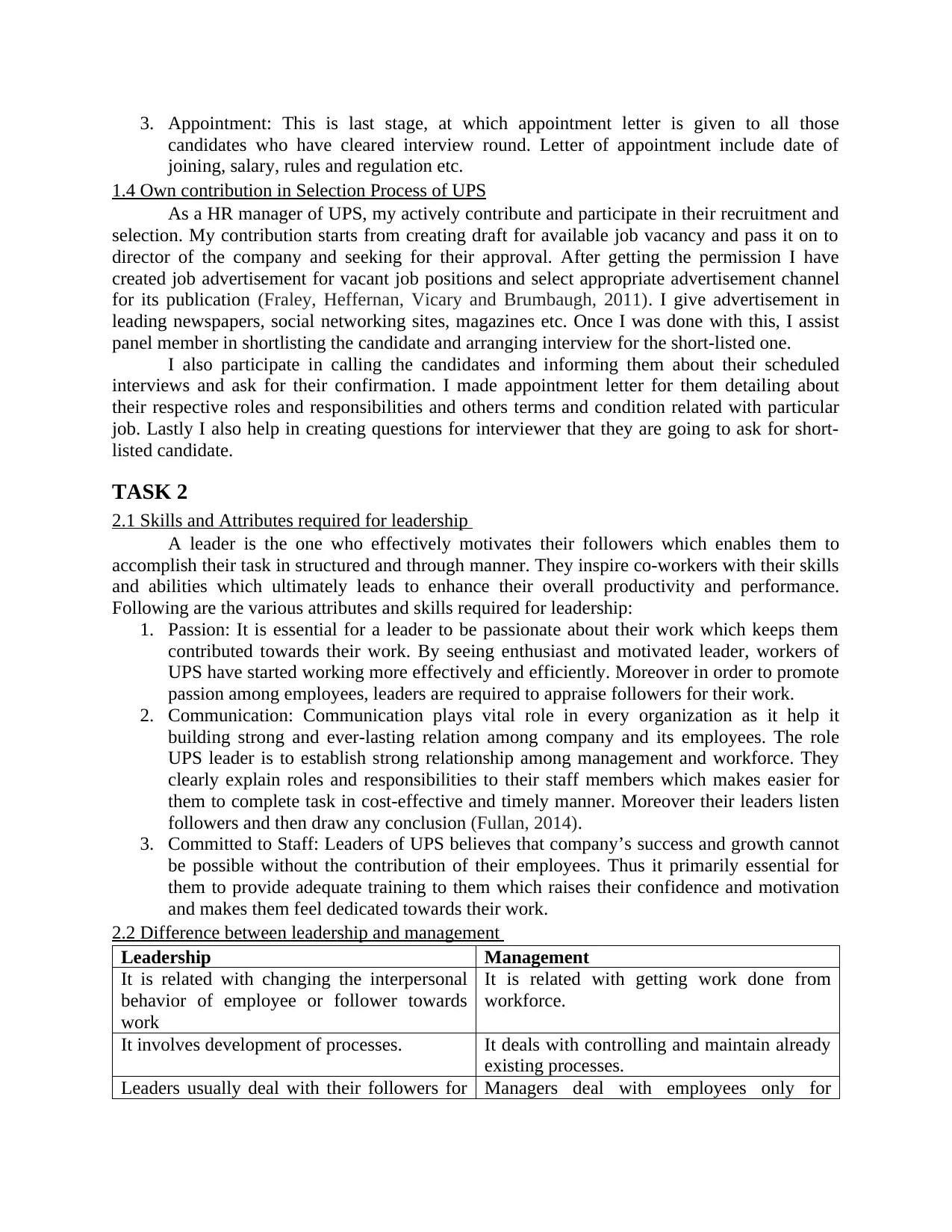
3. Appointment: This is last stage, at which appointment letter is given to all those
candidates who have cleared interview round. Letter of appointment include date of
joining, salary, rules and regulation etc.
1.4 Own contribution in Selection Process of UPS
As a HR manager of UPS, my actively contribute and participate in their recruitment and
selection. My contribution starts from creating draft for available job vacancy and pass it on to
director of the company and seeking for their approval. After getting the permission I have
created job advertisement for vacant job positions and select appropriate advertisement channel
for its publication (Fraley, Heffernan, Vicary and Brumbaugh, 2011). I give advertisement in
leading newspapers, social networking sites, magazines etc. Once I was done with this, I assist
panel member in shortlisting the candidate and arranging interview for the short-listed one.
I also participate in calling the candidates and informing them about their scheduled
interviews and ask for their confirmation. I made appointment letter for them detailing about
their respective roles and responsibilities and others terms and condition related with particular
job. Lastly I also help in creating questions for interviewer that they are going to ask for short-
listed candidate.
TASK 2
2.1 Skills and Attributes required for leadership
A leader is the one who effectively motivates their followers which enables them to
accomplish their task in structured and through manner. They inspire co-workers with their skills
and abilities which ultimately leads to enhance their overall productivity and performance.
Following are the various attributes and skills required for leadership:
1. Passion: It is essential for a leader to be passionate about their work which keeps them
contributed towards their work. By seeing enthusiast and motivated leader, workers of
UPS have started working more effectively and efficiently. Moreover in order to promote
passion among employees, leaders are required to appraise followers for their work.
2. Communication: Communication plays vital role in every organization as it help it
building strong and ever-lasting relation among company and its employees. The role
UPS leader is to establish strong relationship among management and workforce. They
clearly explain roles and responsibilities to their staff members which makes easier for
them to complete task in cost-effective and timely manner. Moreover their leaders listen
followers and then draw any conclusion (Fullan, 2014).
3. Committed to Staff: Leaders of UPS believes that company’s success and growth cannot
be possible without the contribution of their employees. Thus it primarily essential for
them to provide adequate training to them which raises their confidence and motivation
and makes them feel dedicated towards their work.
2.2 Difference between leadership and management
Leadership Management
It is related with changing the interpersonal
behavior of employee or follower towards
work
It is related with getting work done from
workforce.
It involves development of processes. It deals with controlling and maintain already
existing processes.
Leaders usually deal with their followers for Managers deal with employees only for
candidates who have cleared interview round. Letter of appointment include date of
joining, salary, rules and regulation etc.
1.4 Own contribution in Selection Process of UPS
As a HR manager of UPS, my actively contribute and participate in their recruitment and
selection. My contribution starts from creating draft for available job vacancy and pass it on to
director of the company and seeking for their approval. After getting the permission I have
created job advertisement for vacant job positions and select appropriate advertisement channel
for its publication (Fraley, Heffernan, Vicary and Brumbaugh, 2011). I give advertisement in
leading newspapers, social networking sites, magazines etc. Once I was done with this, I assist
panel member in shortlisting the candidate and arranging interview for the short-listed one.
I also participate in calling the candidates and informing them about their scheduled
interviews and ask for their confirmation. I made appointment letter for them detailing about
their respective roles and responsibilities and others terms and condition related with particular
job. Lastly I also help in creating questions for interviewer that they are going to ask for short-
listed candidate.
TASK 2
2.1 Skills and Attributes required for leadership
A leader is the one who effectively motivates their followers which enables them to
accomplish their task in structured and through manner. They inspire co-workers with their skills
and abilities which ultimately leads to enhance their overall productivity and performance.
Following are the various attributes and skills required for leadership:
1. Passion: It is essential for a leader to be passionate about their work which keeps them
contributed towards their work. By seeing enthusiast and motivated leader, workers of
UPS have started working more effectively and efficiently. Moreover in order to promote
passion among employees, leaders are required to appraise followers for their work.
2. Communication: Communication plays vital role in every organization as it help it
building strong and ever-lasting relation among company and its employees. The role
UPS leader is to establish strong relationship among management and workforce. They
clearly explain roles and responsibilities to their staff members which makes easier for
them to complete task in cost-effective and timely manner. Moreover their leaders listen
followers and then draw any conclusion (Fullan, 2014).
3. Committed to Staff: Leaders of UPS believes that company’s success and growth cannot
be possible without the contribution of their employees. Thus it primarily essential for
them to provide adequate training to them which raises their confidence and motivation
and makes them feel dedicated towards their work.
2.2 Difference between leadership and management
Leadership Management
It is related with changing the interpersonal
behavior of employee or follower towards
work
It is related with getting work done from
workforce.
It involves development of processes. It deals with controlling and maintain already
existing processes.
Leaders usually deal with their followers for Managers deal with employees only for
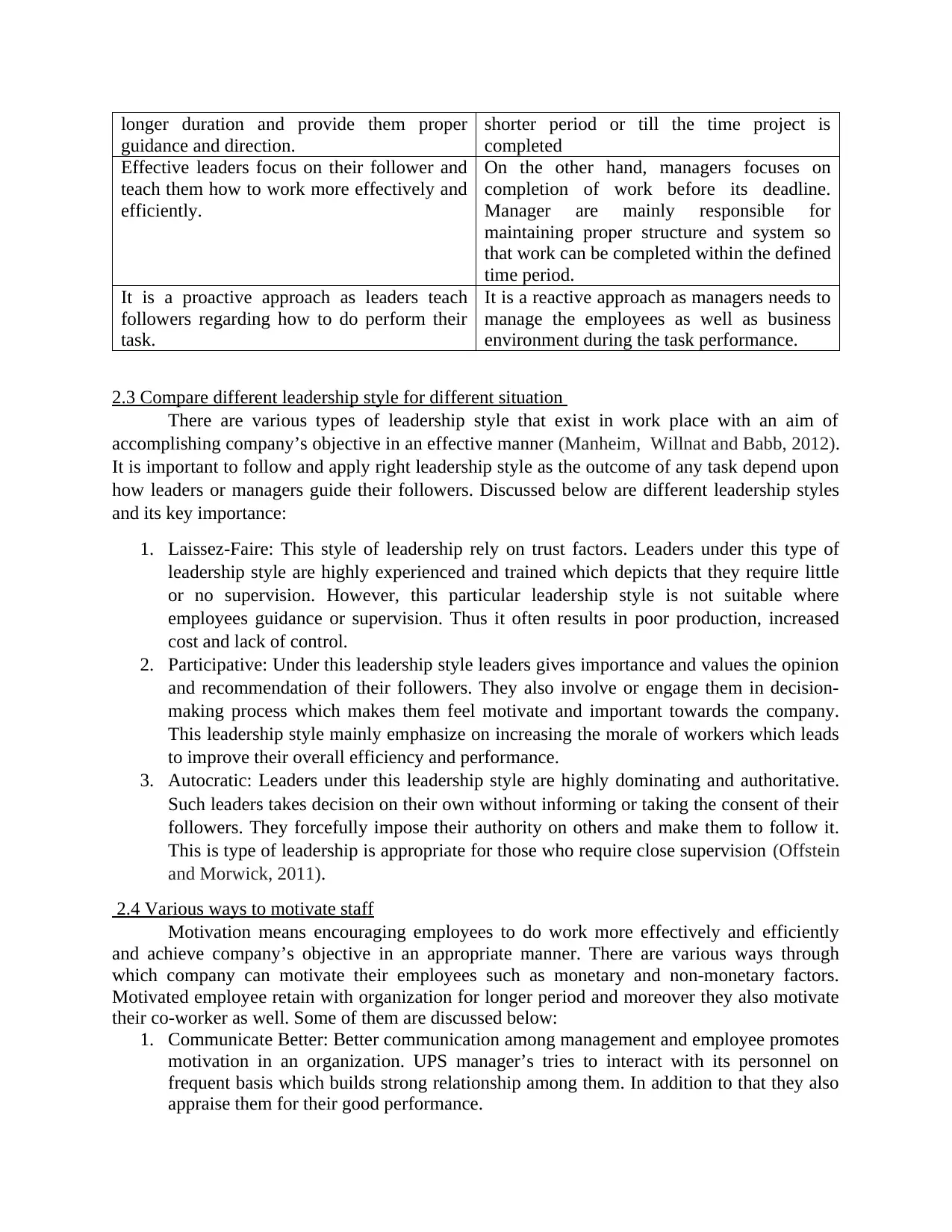
longer duration and provide them proper
guidance and direction.
shorter period or till the time project is
completed
Effective leaders focus on their follower and
teach them how to work more effectively and
efficiently.
On the other hand, managers focuses on
completion of work before its deadline.
Manager are mainly responsible for
maintaining proper structure and system so
that work can be completed within the defined
time period.
It is a proactive approach as leaders teach
followers regarding how to do perform their
task.
It is a reactive approach as managers needs to
manage the employees as well as business
environment during the task performance.
2.3 Compare different leadership style for different situation
There are various types of leadership style that exist in work place with an aim of
accomplishing company’s objective in an effective manner (Manheim, Willnat and Babb, 2012).
It is important to follow and apply right leadership style as the outcome of any task depend upon
how leaders or managers guide their followers. Discussed below are different leadership styles
and its key importance:
1. Laissez-Faire: This style of leadership rely on trust factors. Leaders under this type of
leadership style are highly experienced and trained which depicts that they require little
or no supervision. However, this particular leadership style is not suitable where
employees guidance or supervision. Thus it often results in poor production, increased
cost and lack of control.
2. Participative: Under this leadership style leaders gives importance and values the opinion
and recommendation of their followers. They also involve or engage them in decision-
making process which makes them feel motivate and important towards the company.
This leadership style mainly emphasize on increasing the morale of workers which leads
to improve their overall efficiency and performance.
3. Autocratic: Leaders under this leadership style are highly dominating and authoritative.
Such leaders takes decision on their own without informing or taking the consent of their
followers. They forcefully impose their authority on others and make them to follow it.
This is type of leadership is appropriate for those who require close supervision (Offstein
and Morwick, 2011).
2.4 Various ways to motivate staff
Motivation means encouraging employees to do work more effectively and efficiently
and achieve company’s objective in an appropriate manner. There are various ways through
which company can motivate their employees such as monetary and non-monetary factors.
Motivated employee retain with organization for longer period and moreover they also motivate
their co-worker as well. Some of them are discussed below:
1. Communicate Better: Better communication among management and employee promotes
motivation in an organization. UPS manager’s tries to interact with its personnel on
frequent basis which builds strong relationship among them. In addition to that they also
appraise them for their good performance.
guidance and direction.
shorter period or till the time project is
completed
Effective leaders focus on their follower and
teach them how to work more effectively and
efficiently.
On the other hand, managers focuses on
completion of work before its deadline.
Manager are mainly responsible for
maintaining proper structure and system so
that work can be completed within the defined
time period.
It is a proactive approach as leaders teach
followers regarding how to do perform their
task.
It is a reactive approach as managers needs to
manage the employees as well as business
environment during the task performance.
2.3 Compare different leadership style for different situation
There are various types of leadership style that exist in work place with an aim of
accomplishing company’s objective in an effective manner (Manheim, Willnat and Babb, 2012).
It is important to follow and apply right leadership style as the outcome of any task depend upon
how leaders or managers guide their followers. Discussed below are different leadership styles
and its key importance:
1. Laissez-Faire: This style of leadership rely on trust factors. Leaders under this type of
leadership style are highly experienced and trained which depicts that they require little
or no supervision. However, this particular leadership style is not suitable where
employees guidance or supervision. Thus it often results in poor production, increased
cost and lack of control.
2. Participative: Under this leadership style leaders gives importance and values the opinion
and recommendation of their followers. They also involve or engage them in decision-
making process which makes them feel motivate and important towards the company.
This leadership style mainly emphasize on increasing the morale of workers which leads
to improve their overall efficiency and performance.
3. Autocratic: Leaders under this leadership style are highly dominating and authoritative.
Such leaders takes decision on their own without informing or taking the consent of their
followers. They forcefully impose their authority on others and make them to follow it.
This is type of leadership is appropriate for those who require close supervision (Offstein
and Morwick, 2011).
2.4 Various ways to motivate staff
Motivation means encouraging employees to do work more effectively and efficiently
and achieve company’s objective in an appropriate manner. There are various ways through
which company can motivate their employees such as monetary and non-monetary factors.
Motivated employee retain with organization for longer period and moreover they also motivate
their co-worker as well. Some of them are discussed below:
1. Communicate Better: Better communication among management and employee promotes
motivation in an organization. UPS manager’s tries to interact with its personnel on
frequent basis which builds strong relationship among them. In addition to that they also
appraise them for their good performance.
⊘ This is a preview!⊘
Do you want full access?
Subscribe today to unlock all pages.

Trusted by 1+ million students worldwide
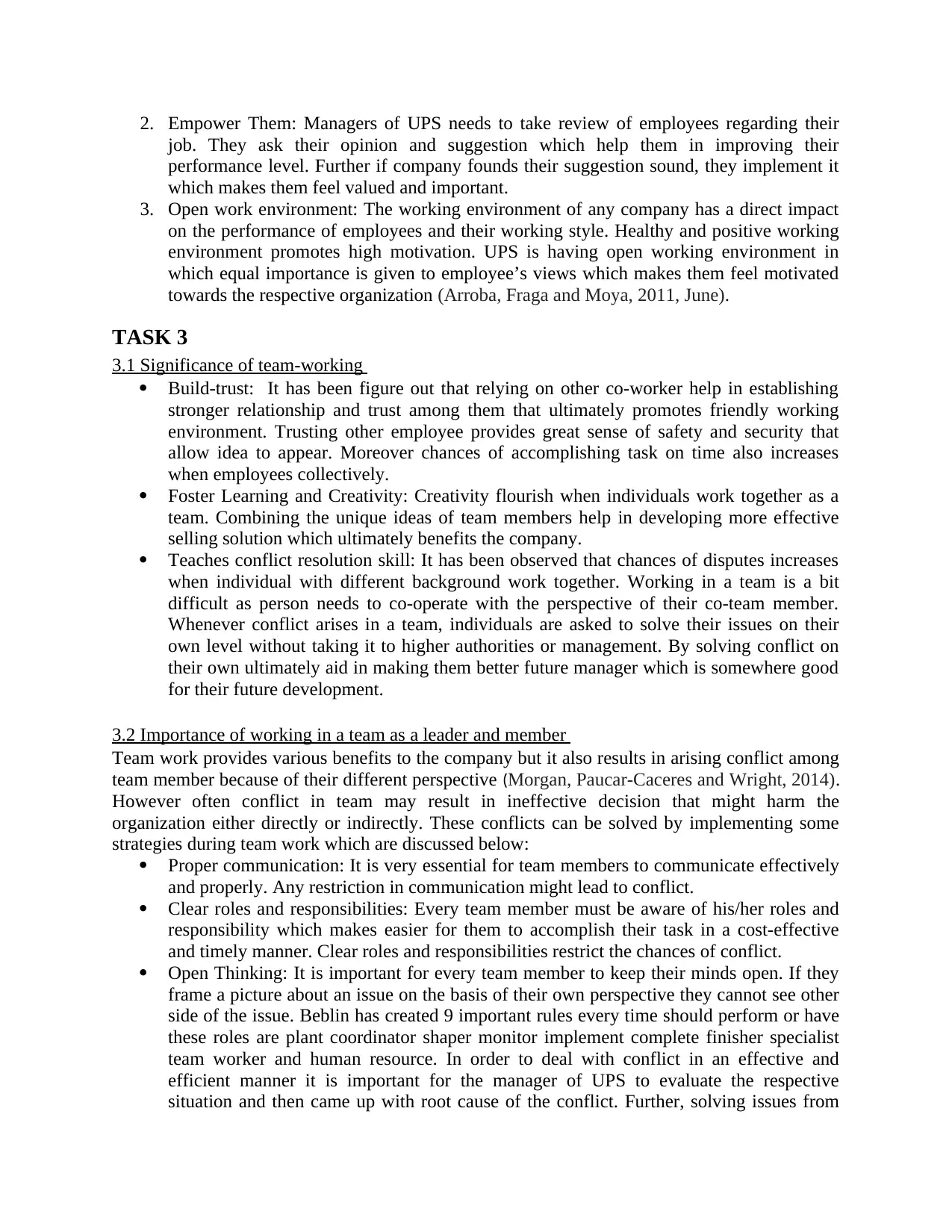
2. Empower Them: Managers of UPS needs to take review of employees regarding their
job. They ask their opinion and suggestion which help them in improving their
performance level. Further if company founds their suggestion sound, they implement it
which makes them feel valued and important.
3. Open work environment: The working environment of any company has a direct impact
on the performance of employees and their working style. Healthy and positive working
environment promotes high motivation. UPS is having open working environment in
which equal importance is given to employee’s views which makes them feel motivated
towards the respective organization (Arroba, Fraga and Moya, 2011, June).
TASK 3
3.1 Significance of team-working
Build-trust: It has been figure out that relying on other co-worker help in establishing
stronger relationship and trust among them that ultimately promotes friendly working
environment. Trusting other employee provides great sense of safety and security that
allow idea to appear. Moreover chances of accomplishing task on time also increases
when employees collectively.
Foster Learning and Creativity: Creativity flourish when individuals work together as a
team. Combining the unique ideas of team members help in developing more effective
selling solution which ultimately benefits the company.
Teaches conflict resolution skill: It has been observed that chances of disputes increases
when individual with different background work together. Working in a team is a bit
difficult as person needs to co-operate with the perspective of their co-team member.
Whenever conflict arises in a team, individuals are asked to solve their issues on their
own level without taking it to higher authorities or management. By solving conflict on
their own ultimately aid in making them better future manager which is somewhere good
for their future development.
3.2 Importance of working in a team as a leader and member
Team work provides various benefits to the company but it also results in arising conflict among
team member because of their different perspective (Morgan, Paucar-Caceres and Wright, 2014).
However often conflict in team may result in ineffective decision that might harm the
organization either directly or indirectly. These conflicts can be solved by implementing some
strategies during team work which are discussed below:
Proper communication: It is very essential for team members to communicate effectively
and properly. Any restriction in communication might lead to conflict.
Clear roles and responsibilities: Every team member must be aware of his/her roles and
responsibility which makes easier for them to accomplish their task in a cost-effective
and timely manner. Clear roles and responsibilities restrict the chances of conflict.
Open Thinking: It is important for every team member to keep their minds open. If they
frame a picture about an issue on the basis of their own perspective they cannot see other
side of the issue. Beblin has created 9 important rules every time should perform or have
these roles are plant coordinator shaper monitor implement complete finisher specialist
team worker and human resource. In order to deal with conflict in an effective and
efficient manner it is important for the manager of UPS to evaluate the respective
situation and then came up with root cause of the conflict. Further, solving issues from
job. They ask their opinion and suggestion which help them in improving their
performance level. Further if company founds their suggestion sound, they implement it
which makes them feel valued and important.
3. Open work environment: The working environment of any company has a direct impact
on the performance of employees and their working style. Healthy and positive working
environment promotes high motivation. UPS is having open working environment in
which equal importance is given to employee’s views which makes them feel motivated
towards the respective organization (Arroba, Fraga and Moya, 2011, June).
TASK 3
3.1 Significance of team-working
Build-trust: It has been figure out that relying on other co-worker help in establishing
stronger relationship and trust among them that ultimately promotes friendly working
environment. Trusting other employee provides great sense of safety and security that
allow idea to appear. Moreover chances of accomplishing task on time also increases
when employees collectively.
Foster Learning and Creativity: Creativity flourish when individuals work together as a
team. Combining the unique ideas of team members help in developing more effective
selling solution which ultimately benefits the company.
Teaches conflict resolution skill: It has been observed that chances of disputes increases
when individual with different background work together. Working in a team is a bit
difficult as person needs to co-operate with the perspective of their co-team member.
Whenever conflict arises in a team, individuals are asked to solve their issues on their
own level without taking it to higher authorities or management. By solving conflict on
their own ultimately aid in making them better future manager which is somewhere good
for their future development.
3.2 Importance of working in a team as a leader and member
Team work provides various benefits to the company but it also results in arising conflict among
team member because of their different perspective (Morgan, Paucar-Caceres and Wright, 2014).
However often conflict in team may result in ineffective decision that might harm the
organization either directly or indirectly. These conflicts can be solved by implementing some
strategies during team work which are discussed below:
Proper communication: It is very essential for team members to communicate effectively
and properly. Any restriction in communication might lead to conflict.
Clear roles and responsibilities: Every team member must be aware of his/her roles and
responsibility which makes easier for them to accomplish their task in a cost-effective
and timely manner. Clear roles and responsibilities restrict the chances of conflict.
Open Thinking: It is important for every team member to keep their minds open. If they
frame a picture about an issue on the basis of their own perspective they cannot see other
side of the issue. Beblin has created 9 important rules every time should perform or have
these roles are plant coordinator shaper monitor implement complete finisher specialist
team worker and human resource. In order to deal with conflict in an effective and
efficient manner it is important for the manager of UPS to evaluate the respective
situation and then came up with root cause of the conflict. Further, solving issues from
Paraphrase This Document
Need a fresh take? Get an instant paraphrase of this document with our AI Paraphraser
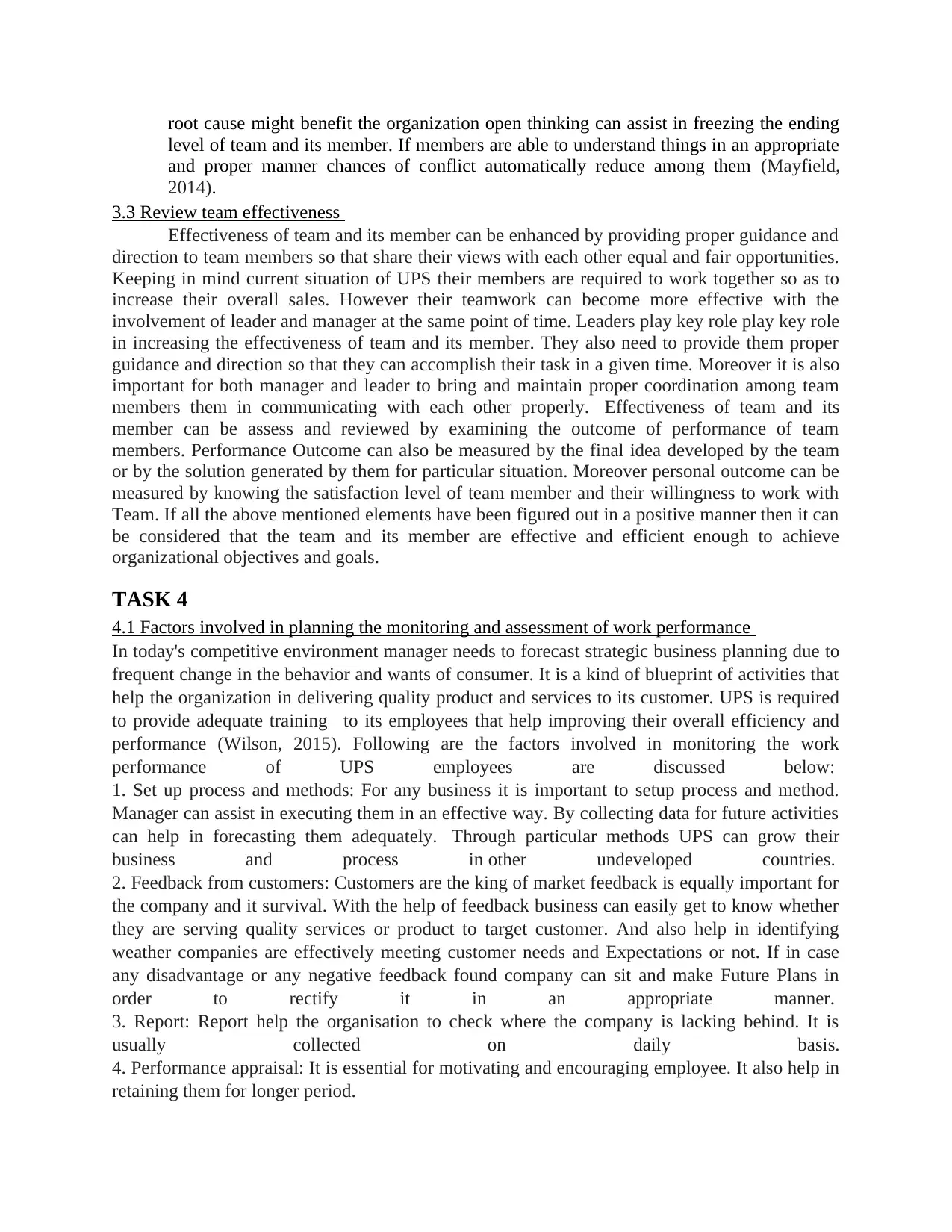
root cause might benefit the organization open thinking can assist in freezing the ending
level of team and its member. If members are able to understand things in an appropriate
and proper manner chances of conflict automatically reduce among them (Mayfield,
2014).
3.3 Review team effectiveness
Effectiveness of team and its member can be enhanced by providing proper guidance and
direction to team members so that share their views with each other equal and fair opportunities.
Keeping in mind current situation of UPS their members are required to work together so as to
increase their overall sales. However their teamwork can become more effective with the
involvement of leader and manager at the same point of time. Leaders play key role play key role
in increasing the effectiveness of team and its member. They also need to provide them proper
guidance and direction so that they can accomplish their task in a given time. Moreover it is also
important for both manager and leader to bring and maintain proper coordination among team
members them in communicating with each other properly. Effectiveness of team and its
member can be assess and reviewed by examining the outcome of performance of team
members. Performance Outcome can also be measured by the final idea developed by the team
or by the solution generated by them for particular situation. Moreover personal outcome can be
measured by knowing the satisfaction level of team member and their willingness to work with
Team. If all the above mentioned elements have been figured out in a positive manner then it can
be considered that the team and its member are effective and efficient enough to achieve
organizational objectives and goals.
TASK 4
4.1 Factors involved in planning the monitoring and assessment of work performance
In today's competitive environment manager needs to forecast strategic business planning due to
frequent change in the behavior and wants of consumer. It is a kind of blueprint of activities that
help the organization in delivering quality product and services to its customer. UPS is required
to provide adequate training to its employees that help improving their overall efficiency and
performance (Wilson, 2015). Following are the factors involved in monitoring the work
performance of UPS employees are discussed below:
1. Set up process and methods: For any business it is important to setup process and method.
Manager can assist in executing them in an effective way. By collecting data for future activities
can help in forecasting them adequately. Through particular methods UPS can grow their
business and process in other undeveloped countries.
2. Feedback from customers: Customers are the king of market feedback is equally important for
the company and it survival. With the help of feedback business can easily get to know whether
they are serving quality services or product to target customer. And also help in identifying
weather companies are effectively meeting customer needs and Expectations or not. If in case
any disadvantage or any negative feedback found company can sit and make Future Plans in
order to rectify it in an appropriate manner.
3. Report: Report help the organisation to check where the company is lacking behind. It is
usually collected on daily basis.
4. Performance appraisal: It is essential for motivating and encouraging employee. It also help in
retaining them for longer period.
level of team and its member. If members are able to understand things in an appropriate
and proper manner chances of conflict automatically reduce among them (Mayfield,
2014).
3.3 Review team effectiveness
Effectiveness of team and its member can be enhanced by providing proper guidance and
direction to team members so that share their views with each other equal and fair opportunities.
Keeping in mind current situation of UPS their members are required to work together so as to
increase their overall sales. However their teamwork can become more effective with the
involvement of leader and manager at the same point of time. Leaders play key role play key role
in increasing the effectiveness of team and its member. They also need to provide them proper
guidance and direction so that they can accomplish their task in a given time. Moreover it is also
important for both manager and leader to bring and maintain proper coordination among team
members them in communicating with each other properly. Effectiveness of team and its
member can be assess and reviewed by examining the outcome of performance of team
members. Performance Outcome can also be measured by the final idea developed by the team
or by the solution generated by them for particular situation. Moreover personal outcome can be
measured by knowing the satisfaction level of team member and their willingness to work with
Team. If all the above mentioned elements have been figured out in a positive manner then it can
be considered that the team and its member are effective and efficient enough to achieve
organizational objectives and goals.
TASK 4
4.1 Factors involved in planning the monitoring and assessment of work performance
In today's competitive environment manager needs to forecast strategic business planning due to
frequent change in the behavior and wants of consumer. It is a kind of blueprint of activities that
help the organization in delivering quality product and services to its customer. UPS is required
to provide adequate training to its employees that help improving their overall efficiency and
performance (Wilson, 2015). Following are the factors involved in monitoring the work
performance of UPS employees are discussed below:
1. Set up process and methods: For any business it is important to setup process and method.
Manager can assist in executing them in an effective way. By collecting data for future activities
can help in forecasting them adequately. Through particular methods UPS can grow their
business and process in other undeveloped countries.
2. Feedback from customers: Customers are the king of market feedback is equally important for
the company and it survival. With the help of feedback business can easily get to know whether
they are serving quality services or product to target customer. And also help in identifying
weather companies are effectively meeting customer needs and Expectations or not. If in case
any disadvantage or any negative feedback found company can sit and make Future Plans in
order to rectify it in an appropriate manner.
3. Report: Report help the organisation to check where the company is lacking behind. It is
usually collected on daily basis.
4. Performance appraisal: It is essential for motivating and encouraging employee. It also help in
retaining them for longer period.
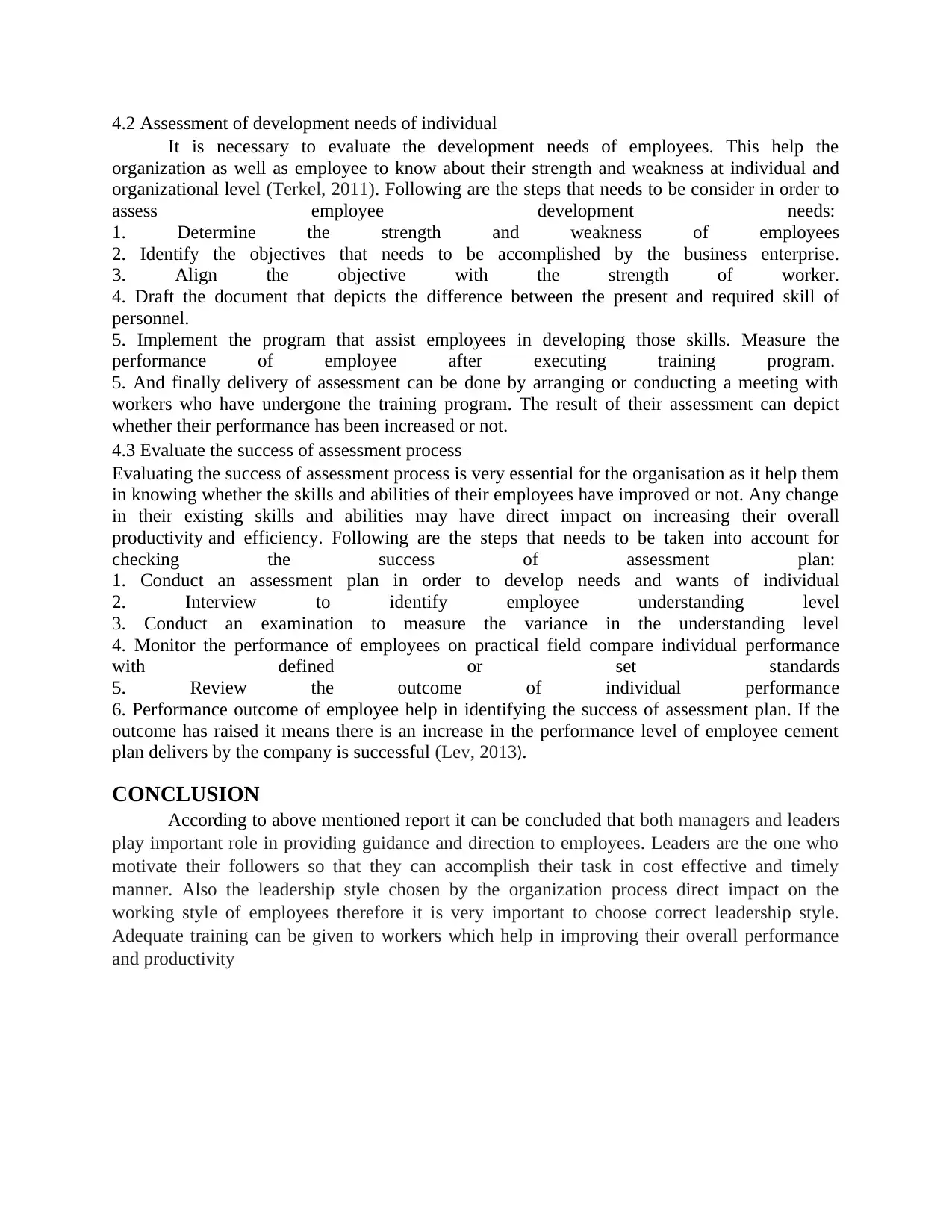
4.2 Assessment of development needs of individual
It is necessary to evaluate the development needs of employees. This help the
organization as well as employee to know about their strength and weakness at individual and
organizational level (Terkel, 2011). Following are the steps that needs to be consider in order to
assess employee development needs:
1. Determine the strength and weakness of employees
2. Identify the objectives that needs to be accomplished by the business enterprise.
3. Align the objective with the strength of worker.
4. Draft the document that depicts the difference between the present and required skill of
personnel.
5. Implement the program that assist employees in developing those skills. Measure the
performance of employee after executing training program.
5. And finally delivery of assessment can be done by arranging or conducting a meeting with
workers who have undergone the training program. The result of their assessment can depict
whether their performance has been increased or not.
4.3 Evaluate the success of assessment process
Evaluating the success of assessment process is very essential for the organisation as it help them
in knowing whether the skills and abilities of their employees have improved or not. Any change
in their existing skills and abilities may have direct impact on increasing their overall
productivity and efficiency. Following are the steps that needs to be taken into account for
checking the success of assessment plan:
1. Conduct an assessment plan in order to develop needs and wants of individual
2. Interview to identify employee understanding level
3. Conduct an examination to measure the variance in the understanding level
4. Monitor the performance of employees on practical field compare individual performance
with defined or set standards
5. Review the outcome of individual performance
6. Performance outcome of employee help in identifying the success of assessment plan. If the
outcome has raised it means there is an increase in the performance level of employee cement
plan delivers by the company is successful (Lev, 2013).
CONCLUSION
According to above mentioned report it can be concluded that both managers and leaders
play important role in providing guidance and direction to employees. Leaders are the one who
motivate their followers so that they can accomplish their task in cost effective and timely
manner. Also the leadership style chosen by the organization process direct impact on the
working style of employees therefore it is very important to choose correct leadership style.
Adequate training can be given to workers which help in improving their overall performance
and productivity
It is necessary to evaluate the development needs of employees. This help the
organization as well as employee to know about their strength and weakness at individual and
organizational level (Terkel, 2011). Following are the steps that needs to be consider in order to
assess employee development needs:
1. Determine the strength and weakness of employees
2. Identify the objectives that needs to be accomplished by the business enterprise.
3. Align the objective with the strength of worker.
4. Draft the document that depicts the difference between the present and required skill of
personnel.
5. Implement the program that assist employees in developing those skills. Measure the
performance of employee after executing training program.
5. And finally delivery of assessment can be done by arranging or conducting a meeting with
workers who have undergone the training program. The result of their assessment can depict
whether their performance has been increased or not.
4.3 Evaluate the success of assessment process
Evaluating the success of assessment process is very essential for the organisation as it help them
in knowing whether the skills and abilities of their employees have improved or not. Any change
in their existing skills and abilities may have direct impact on increasing their overall
productivity and efficiency. Following are the steps that needs to be taken into account for
checking the success of assessment plan:
1. Conduct an assessment plan in order to develop needs and wants of individual
2. Interview to identify employee understanding level
3. Conduct an examination to measure the variance in the understanding level
4. Monitor the performance of employees on practical field compare individual performance
with defined or set standards
5. Review the outcome of individual performance
6. Performance outcome of employee help in identifying the success of assessment plan. If the
outcome has raised it means there is an increase in the performance level of employee cement
plan delivers by the company is successful (Lev, 2013).
CONCLUSION
According to above mentioned report it can be concluded that both managers and leaders
play important role in providing guidance and direction to employees. Leaders are the one who
motivate their followers so that they can accomplish their task in cost effective and timely
manner. Also the leadership style chosen by the organization process direct impact on the
working style of employees therefore it is very important to choose correct leadership style.
Adequate training can be given to workers which help in improving their overall performance
and productivity
⊘ This is a preview!⊘
Do you want full access?
Subscribe today to unlock all pages.

Trusted by 1+ million students worldwide
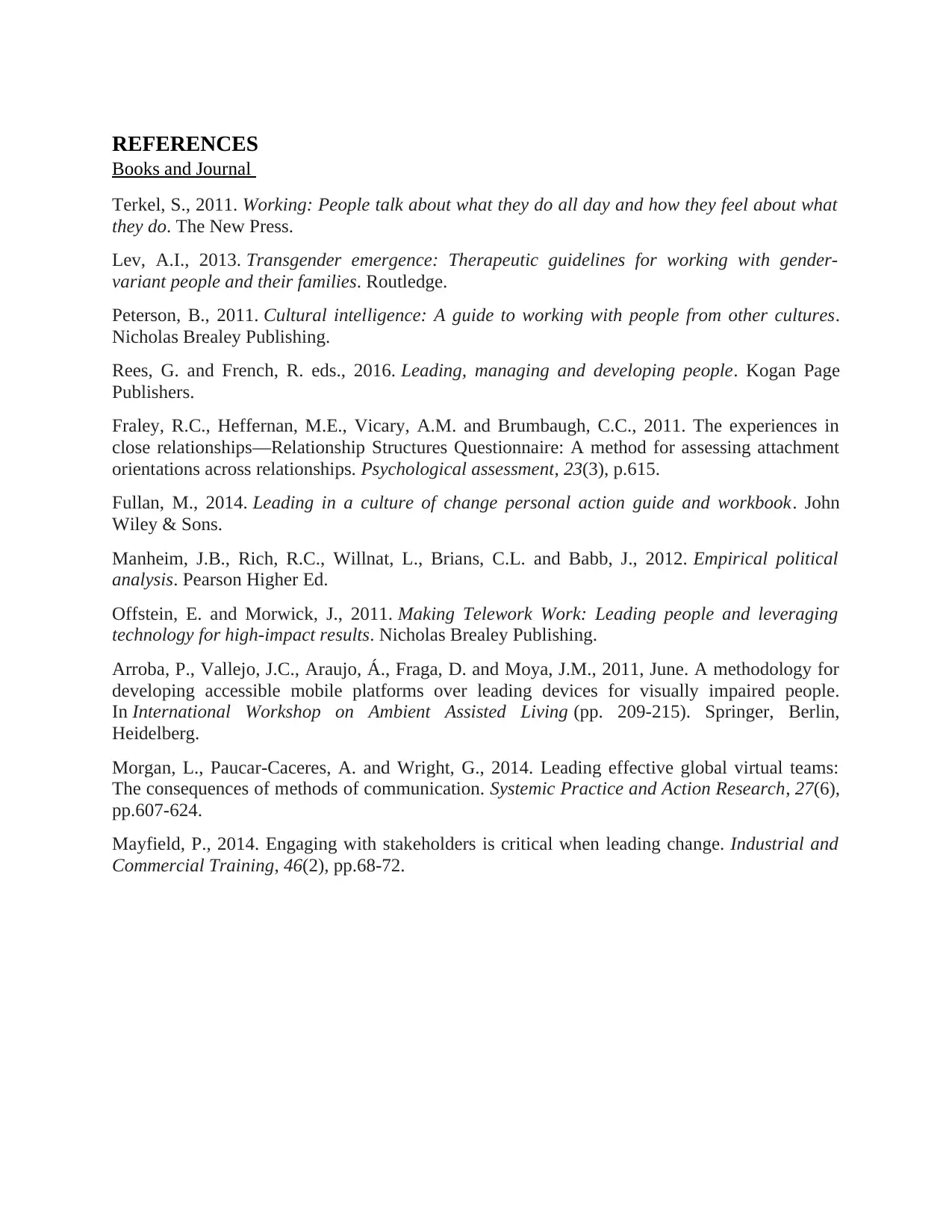
REFERENCES
Books and Journal
Terkel, S., 2011. Working: People talk about what they do all day and how they feel about what
they do. The New Press.
Lev, A.I., 2013. Transgender emergence: Therapeutic guidelines for working with gender-
variant people and their families. Routledge.
Peterson, B., 2011. Cultural intelligence: A guide to working with people from other cultures.
Nicholas Brealey Publishing.
Rees, G. and French, R. eds., 2016. Leading, managing and developing people. Kogan Page
Publishers.
Fraley, R.C., Heffernan, M.E., Vicary, A.M. and Brumbaugh, C.C., 2011. The experiences in
close relationships—Relationship Structures Questionnaire: A method for assessing attachment
orientations across relationships. Psychological assessment, 23(3), p.615.
Fullan, M., 2014. Leading in a culture of change personal action guide and workbook. John
Wiley & Sons.
Manheim, J.B., Rich, R.C., Willnat, L., Brians, C.L. and Babb, J., 2012. Empirical political
analysis. Pearson Higher Ed.
Offstein, E. and Morwick, J., 2011. Making Telework Work: Leading people and leveraging
technology for high-impact results. Nicholas Brealey Publishing.
Arroba, P., Vallejo, J.C., Araujo, Á., Fraga, D. and Moya, J.M., 2011, June. A methodology for
developing accessible mobile platforms over leading devices for visually impaired people.
In International Workshop on Ambient Assisted Living (pp. 209-215). Springer, Berlin,
Heidelberg.
Morgan, L., Paucar-Caceres, A. and Wright, G., 2014. Leading effective global virtual teams:
The consequences of methods of communication. Systemic Practice and Action Research, 27(6),
pp.607-624.
Mayfield, P., 2014. Engaging with stakeholders is critical when leading change. Industrial and
Commercial Training, 46(2), pp.68-72.
Books and Journal
Terkel, S., 2011. Working: People talk about what they do all day and how they feel about what
they do. The New Press.
Lev, A.I., 2013. Transgender emergence: Therapeutic guidelines for working with gender-
variant people and their families. Routledge.
Peterson, B., 2011. Cultural intelligence: A guide to working with people from other cultures.
Nicholas Brealey Publishing.
Rees, G. and French, R. eds., 2016. Leading, managing and developing people. Kogan Page
Publishers.
Fraley, R.C., Heffernan, M.E., Vicary, A.M. and Brumbaugh, C.C., 2011. The experiences in
close relationships—Relationship Structures Questionnaire: A method for assessing attachment
orientations across relationships. Psychological assessment, 23(3), p.615.
Fullan, M., 2014. Leading in a culture of change personal action guide and workbook. John
Wiley & Sons.
Manheim, J.B., Rich, R.C., Willnat, L., Brians, C.L. and Babb, J., 2012. Empirical political
analysis. Pearson Higher Ed.
Offstein, E. and Morwick, J., 2011. Making Telework Work: Leading people and leveraging
technology for high-impact results. Nicholas Brealey Publishing.
Arroba, P., Vallejo, J.C., Araujo, Á., Fraga, D. and Moya, J.M., 2011, June. A methodology for
developing accessible mobile platforms over leading devices for visually impaired people.
In International Workshop on Ambient Assisted Living (pp. 209-215). Springer, Berlin,
Heidelberg.
Morgan, L., Paucar-Caceres, A. and Wright, G., 2014. Leading effective global virtual teams:
The consequences of methods of communication. Systemic Practice and Action Research, 27(6),
pp.607-624.
Mayfield, P., 2014. Engaging with stakeholders is critical when leading change. Industrial and
Commercial Training, 46(2), pp.68-72.
1 out of 10
Related Documents
Your All-in-One AI-Powered Toolkit for Academic Success.
+13062052269
info@desklib.com
Available 24*7 on WhatsApp / Email
![[object Object]](/_next/static/media/star-bottom.7253800d.svg)
Unlock your academic potential
Copyright © 2020–2025 A2Z Services. All Rights Reserved. Developed and managed by ZUCOL.





